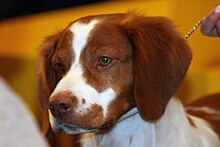| Brittany Spaniel | |||||||||||||||||||||
|---|---|---|---|---|---|---|---|---|---|---|---|---|---|---|---|---|---|---|---|---|---|
 Adult Brittany with a natural bobtail Adult Brittany with a natural bobtail | |||||||||||||||||||||
| Other names | Breton Spaniel Brittany Brittany Wiegref Epagneul Breton French Brittany | ||||||||||||||||||||
| Origin | Brittany, France | ||||||||||||||||||||
| |||||||||||||||||||||
| |||||||||||||||||||||
| Dog (domestic dog) | |||||||||||||||||||||
The Brittany Spaniel or Breton Spaniel (French: Épagneul Breton) is a French breed of gun dog of spaniel type, bred primarily for bird hunting.
It developed between the seventeenth and nineteenth centuries in Brittany in north-west France, and was officially recognized early in the twentieth. The breed has developed differently in the United States, where it may be referred to as the 'American Brittany'.
History
The name "Brittany" is taken from the Brittany region in northwestern France where the dog originated. Images of orange and white Brittany-like dogs hunting and retrieving game were first seen on tapestries and paintings from the 17th century. The first written and verifiable record of Brittanys comes from a hunting description written by Reverend Davies in 1850. He described hunting with small "bobtailed" dogs who pointed and were excellent retrievers. It was around the same time that the modern Brittany is rumored to have been bred by mating with English Setters.
The Brittany was first recognized as a breed in 1907 when an orange and white male named Boy was registered in France. As a result, the first standards were outlined in the same year. America recognized the Brittany in 1931 and the breed was approved by the American Kennel Club in 1934. In 1982 the "Spaniel" was officially dropped from the name.
Description



Appearance
The Brittany is a dog with a spaniel-type head, a bob-tail, and cobby appearance.
Most Brittanys are born with long tails, subsequently docked to a length of 3–10 centimetres (1.2–3.9 in), however sometimes they are born with short tails.
The breed's coat color is varied: an orange and white coat or liver and white are most common in the American Brittany; other colors include orange roan and liver roan, all of which are acceptable in the show ring. The American Brittany Standard specifies an acceptable tri-color of liver, orange, and white with very specific color placement. French Brittanys also come in white and black.
Size
Brittanys are medium-sized dogs, with American lines (17.5–20.5 inches (44–52 cm) at the withers according to an AKC standard adopted in 1990 tending to be larger and have a blockier head than French (17–20.5 inches (43–52 cm)), and females at the lower end. A properly constructed and healthy Brittany maintains a weight between 30–45 pounds (14–20 kg), depending upon height. Generally, Brittanys are smaller than setters but leggier than spaniels.
Types
Many breeders differentiate between "American" Brittanys and "French"-style dogs. Although generally recognized as subsets of the same breed, there are recognizable differences between the two. The "American Brittany" has been bred to be typically larger than the "French Brittany".
Temperament
The Brittany was originally bred as a hunting dog and noted for being easy to train and sweet-natured. The breed is generally more sensitive to correction than other hunters, and harsh corrections are often unnecessary.
Health

A 2015 French study found an average life expectancy of 12.6 years. A 2024 UK study found an average life expectancy of 11.1 years for the breed compared to an average of 12.7 for purebreeds and 12 for crossbreeds.
A North American study looking at over a million dogs found the Brittany to be predisposed to hip dysplasia with 4.22% of Brittanys having hip dysplasia compared to 3.52% overall. Another North American study looking at over 250,000 elbow records found the Brittany to have the 14th lowest rate of elbow dysplasia out of 60 breeds with 1.7% of Brittanys having elbow dysplasia.
A North American study found the Brittany to have a higher incidence of glaucoma than other dogs with 0.95% of Brittanys having glaucoma compared to 0.89% overall.
See also
References
- ^ Leroy, G. G.; Phocas, F.; Hedan, B.; Verrier, E.; Rognon, X. (2015). "Inbreeding impact on litter size and survival in selected canine breeds". The Veterinary Journal. 203 (1): 74–8. doi:10.1016/j.tvjl.2014.11.008. PMID 25475165. S2CID 27631883. mean=11.34 ± 4.28 median =12.58
- ^ "Brittany Standard" (PDF). Federation Cynologique Internationale. Retrieved 25 February 2024.
- Riddle, Maxwell (1974). The complete Brittany spaniel. New York: Howell Book House. pp. 28. ISBN 9780876050651.
- ^ "Brittany". American Kennel Club. Archived from the original on 2015-02-15.
- ^ "Brittany Standard" (PDF). American Kennel Club. Retrieved 25 February 2024.
- "Brittany". United Kennel Club. Archived from the original on 5 March 2016. Retrieved 4 October 2015.
- Thoms, Jerry. "The French Brittany". The Gundog Mag. Archived from the original on 16 June 2007. Retrieved 9 March 2014.
- Kilcommons, Brian; Wilson, Sarah (1999). Paws to Consider. New York, NY: Warner Books. pp. 132–133. ISBN 0-446-52151-5.
- McMillan, Kirsten M.; Bielby, Jon; Williams, Carys L.; Upjohn, Melissa M.; Casey, Rachel A.; Christley, Robert M. (2024-02-01). "Longevity of companion dog breeds: those at risk from early death". Scientific Reports. 14 (1). Springer Science and Business Media LLC. doi:10.1038/s41598-023-50458-w. ISSN 2045-2322. PMC 10834484.
- Witsberger, Tige H.; Villamil, J. Armando; Schultz, Loren G.; Hahn, Allen W.; Cook, James L. (2008-06-15). "Prevalence of and risk factors for hip dysplasia and cranial cruciate ligament deficiency in dogs". Journal of the American Veterinary Medical Association. 232 (12). American Veterinary Medical Association (AVMA): 1818–1824. doi:10.2460/javma.232.12.1818. ISSN 0003-1488. PMID 18598150.
- Oberbauer, A. M.; Keller, G. G.; Famula, T. R. (2017-02-24). "Long-term genetic selection reduced prevalence of hip and elbow dysplasia in 60 dog breeds". PLOS ONE. 12 (2). Public Library of Science (PLoS): e0172918. Bibcode:2017PLoSO..1272918O. doi:10.1371/journal.pone.0172918. ISSN 1932-6203. PMC 5325577. PMID 28234985.
- Gelatt, Kirk N.; MacKay, Edward O. (2004). "Prevalence of the breed-related glaucomas in pure-bred dogs in North America". Veterinary Ophthalmology. 7 (2): 97–111. doi:10.1111/j.1463-5224.2004.04006.x. ISSN 1463-5216. PMID 14982589.